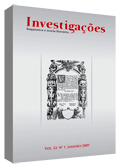A cidade íntima – o olhar de João Cabral sobre a condição urbana
Abstract
Analisamos neste artigo a representação da condição urbana na poesia de João Cabral de Melo Neto. Depois do crescimento acelerado das cidades e da implantação dos grandes centros comerciais, o eu-lírico parece ser um estranho em sua própria comunidade; por isso procura resgatar o tempo quando as pessoas mantinham uma relação mais íntima e duradoura com os ambientes citadinos. Nesse sentido, o saudosismo corresponde a uma atitude de resistência contra as atrocidades da sociedade capitalista, permitindo que a obra de João Cabral atinja um nítido processo de humanização.References
ARGAN, Giulio Carlo. 1998. História da arte como história da cidade. 4ª Ed. São Paulo: Martins Fontes.
AZEVEDO, Ricardo Marque de. Metrópole: abstração. São Paulo: Perspectiva, 2006.
BANDEIRA, Manuel. 1966. Estrela da vida inteira. Rio de Janeiro: José Olympio.
BENEVOLO, Leonardo. 1991. A cidade e o arquiteto. 2ª Ed. São Paulo: Perspectiva.
BOSI, Alfredo. 2004. O ser e o tempo da poesia. 7ª Ed. São Paulo: Companhia das Letras.
CARDOSO, Joaquim. 1971. Poesias completas. Rio de Janeiro: Civilização Brasileira.
COELHO NETTO, J. Teixeira. 1997. A construção do sentido na arquitetura. 3ª Ed. São Paulo: Perspectiva.
MELO NETO, João Cabral de 1997a. Serial e antes. Rio de Janeiro: Nova Fronteira.
______. 1997b. A educação pela pedra e depois. Rio de Janeiro: Nova Fronteira.
MERQUIOR, José Guilherme. 1972. Nuvem civil sonhada. In. –. A astúcia da mimese: ensaios sobre crítica. Rio de Janeiro: José Olympio.
MUMFOR, Lewis. 2004. A cidade na história: suas origens, transformações e perspectivas. 4ª ed. São Paulo, Martins Fontes.
Downloads
Published
How to Cite
Issue
Section
License
Copyright (c) 2009 André Pinheiro

This work is licensed under a Creative Commons Attribution 4.0 International License.
Authors who publish with Revista Investigações agree to the following terms:
Authors retain copyright and grant the journal right of first publication with the work simultaneously licensed under the Creative Commons Attribution 4.0 International (CC BY 4.0) license that allows others to share the work with an acknowledgement of the work's authorship and initial publication in this journal.
Authors are able to enter into separate, additional contractual arrangements for the non-exclusive distribution of the journal's published version of the work (e.g., post it to an institutional repository or publish it in a book), with an acknowledgement of its initial publication in this journal.
You are free to:
Share — copy and redistribute the material in any medium or format for any purpose, even commercially.
Adapt — remix, transform, and build upon the material for any purpose, even commercially.
The licensor cannot revoke these freedoms as long as you follow the license terms.
Under the following terms:
Attribution — You must give appropriate credit , provide a link to the license, and indicate if changes were made . You may do so in any reasonable manner, but not in any way that suggests the licensor endorses you or your use.
No additional restrictions — You may not apply legal terms or technological measures that legally restrict others from doing anything the license permits.

